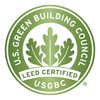
Leed Certified
Standard Owners (1)
| Name | Country | |
|---|---|---|
| LEED | 🇺🇸 United States |
About (Leed Certified)
LEED, which stands for Leadership in Energy and Environmental Design, is a widely recognized green building certification program developed by the United States Green Building Council (USGBC). It provides a framework for assessing and certifying the sustainability and environmental performance of buildings.
LEED certification is available for various types of buildings, including commercial, residential, healthcare, educational, and institutional structures. It evaluates a building's performance across several categories, including sustainable site development, water efficiency, energy efficiency, materials selection, indoor environmental quality, and innovation in design.
To achieve LEED certification, a building project must earn points by meeting specific criteria within each category. The number of points earned determines the level of certification: Certified, Silver, Gold, or Platinum. The certification process involves registering the project with the USGBC, submitting documentation, and undergoing a review by a third-party Green Rater or LEED Accredited Professional.
LEED certification promotes sustainable building practices and aims to reduce the environmental impact of buildings. It encourages energy efficiency, the use of renewable energy sources, water conservation, waste reduction, and the selection of environmentally friendly materials. LEED-certified buildings typically incorporate features such as efficient lighting systems, optimized HVAC (heating, ventilation, and air conditioning) systems, water-efficient fixtures, and sustainable landscaping.
Benefits of LEED certification include lower operating costs, improved energy and water efficiency, enhanced occupant health and comfort, reduced greenhouse gas emissions, and increased property value. LEED-certified buildings are also recognized for their commitment to sustainability and often attract environmentally conscious tenants or occupants.
It's important to note that LEED certifications are based on a voluntary program and can vary by region or country. The USGBC periodically updates the LEED rating system to reflect advancements in sustainable building practices and address emerging environmental challenges.
LEED has become a global standard for sustainable building certification, with projects in more than 165 countries participating in the program. It has had a significant impact on promoting sustainable design, construction, and operation of buildings worldwide.